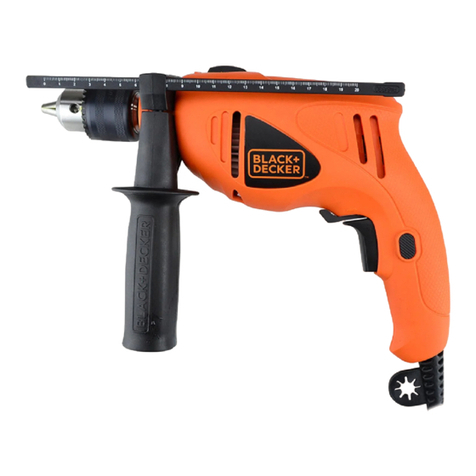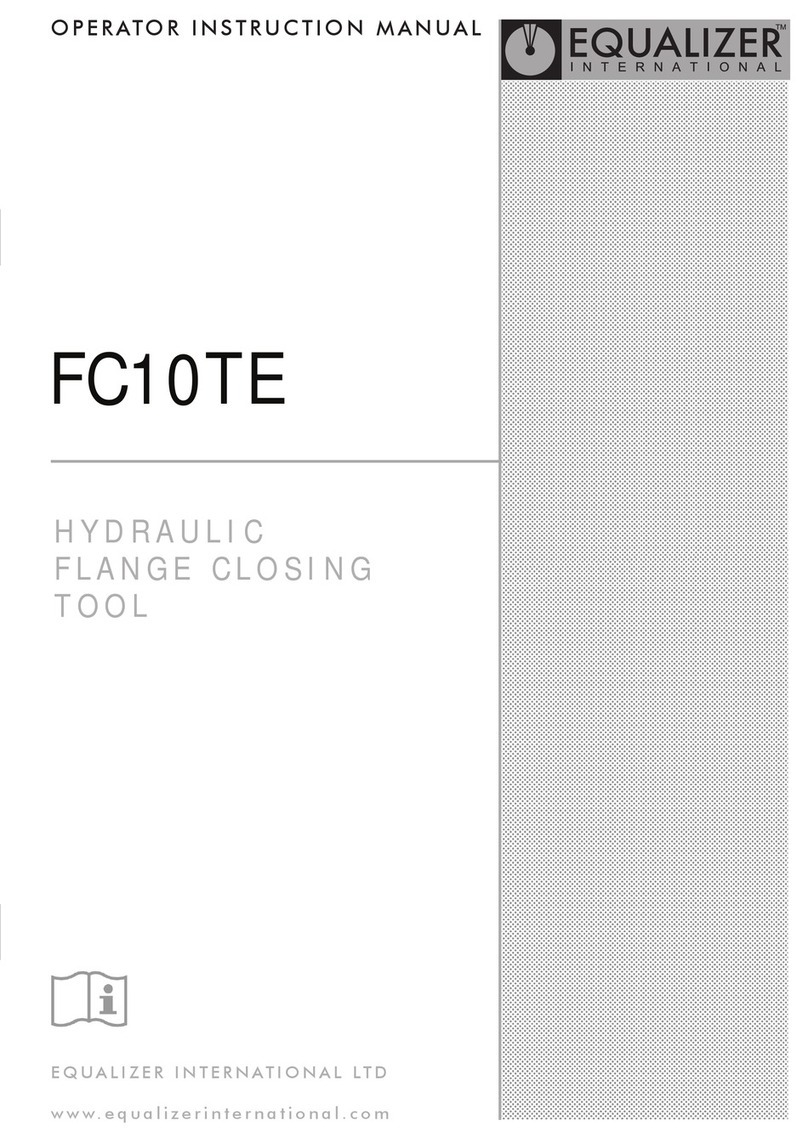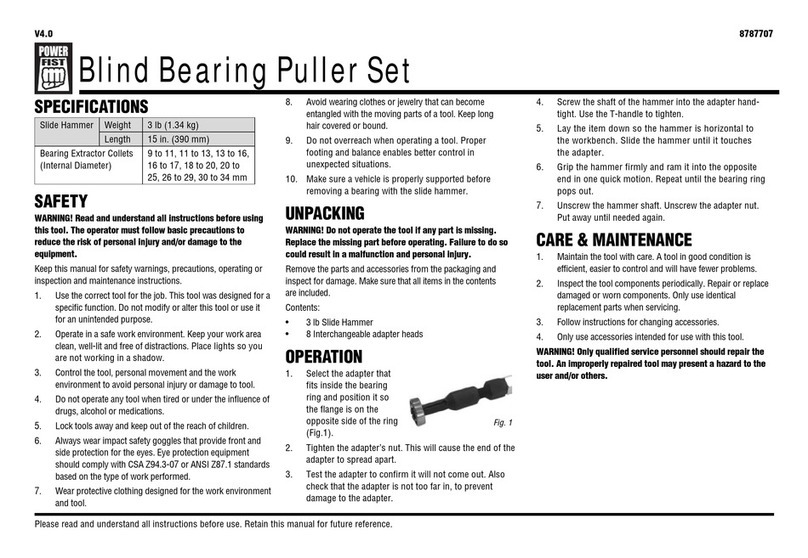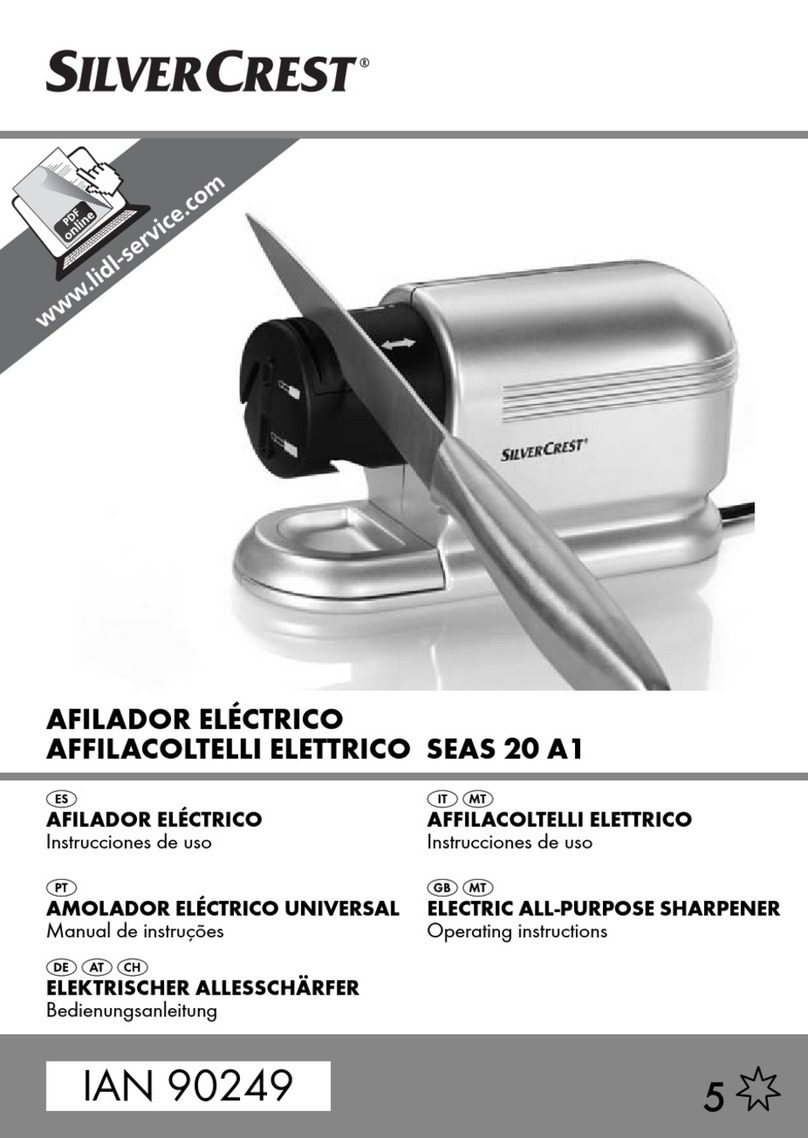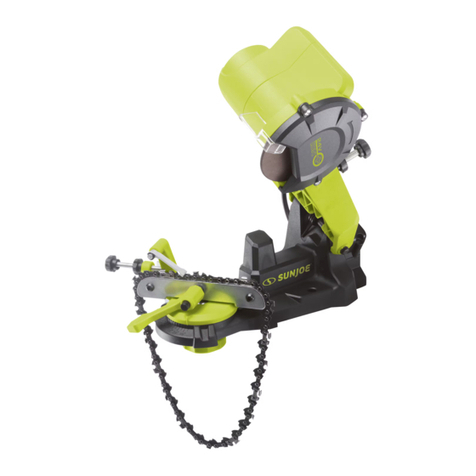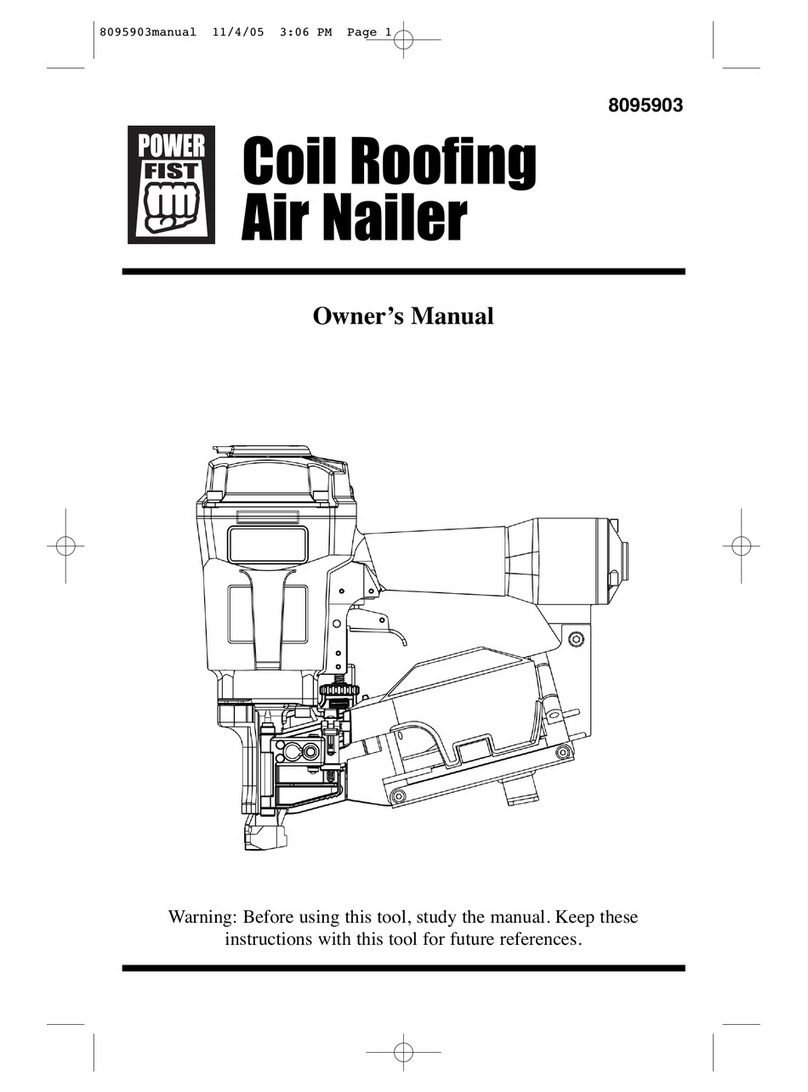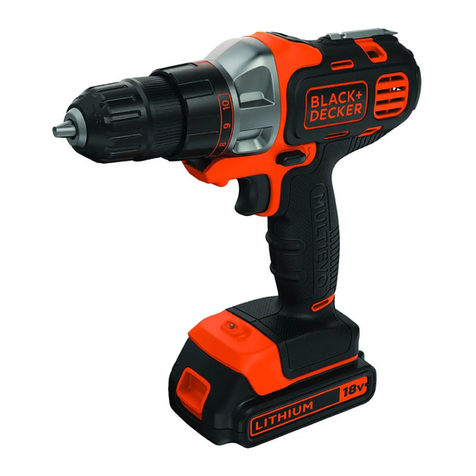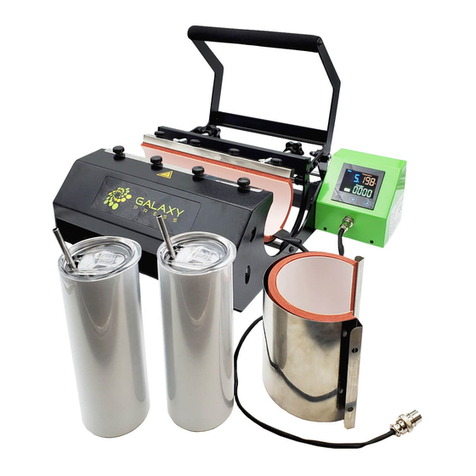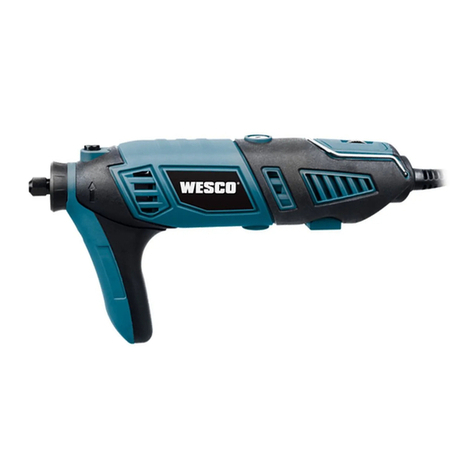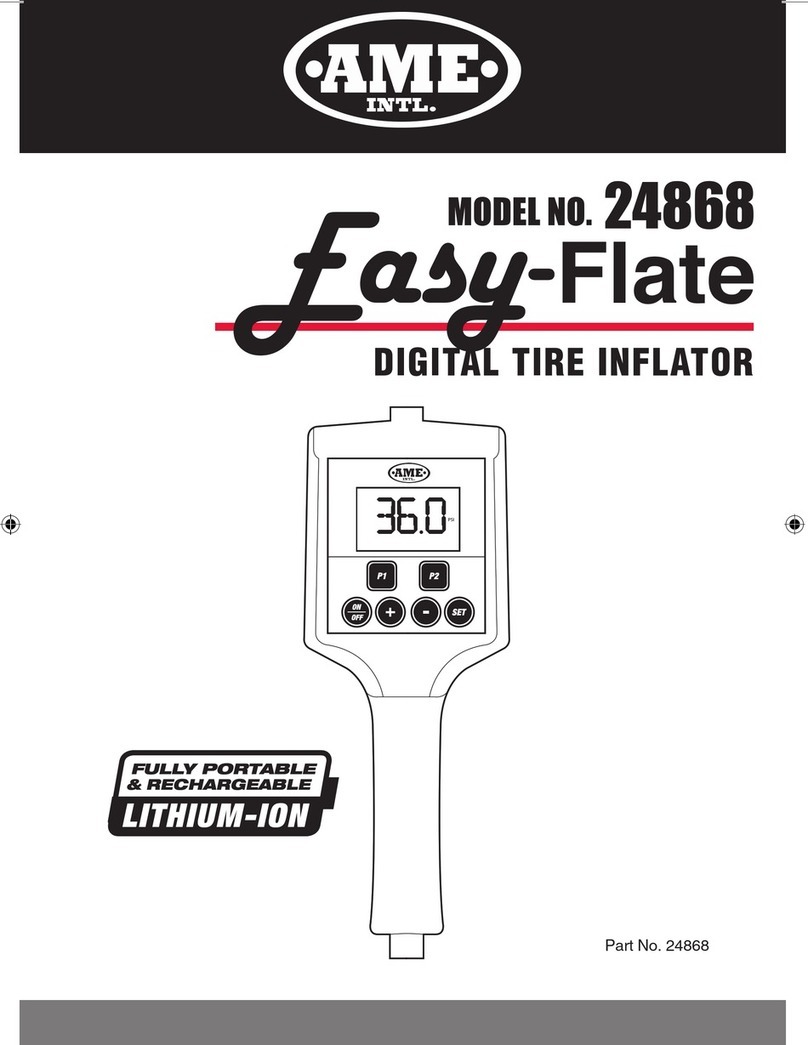ERNI EPC 3 X Series User manual

19.03.2008 / BA_EPC 3x-X
EPC 3x-X
ERNIPRESS CENTER
Hydropneumatic Press
with pneumatic control
Operating manual
EPC 31-X
EPC 33-X
EPC 35-X
EPC 37-X

EPC 3x-X Hydropneumatic Press
Copyright
19.03.08 BA_EPC 3x-X
Copyright
The technical documentation consists of
•operating manual
•calibration certificate
•CE declaration of conformity
Copyright - ERNI Electronics GmbH, Adelberg
This document is intended only for the recipient of the machine.
It may only be used for the intended purpose.
The technical documentation must not be reproduced in any form whatsoever or translated into
other languages, even in extract form, without written consent.
All information and illustrations correct as of March 2008.
All rights reserved
ERNI Electronics GmbH
Seestr. 9
D-73099 Adelberg
Telephone 0049(0)7166/50-0
Fax 0049(0)7166/50-282
www.erni.com
e-mail: info@erni.de

EPC 3x-X Hydropneumatic Press
Confirmation of reading by operating personnel
19.03.08 BA_EPC 3x-X
Confirmation of reading by operating personnel
CAUTION!
Read through the following operating manual and the accompanying documentation be-
fore working with the press!
You may only work on the press if you have read and understood the operating manual and
accompanying documentation.
Do not hesitate to contact your supervisor or ERNI GmbH if you have any questions.
Declaration:
I hereby confirm that I have read and understood the following operating manual in full.
No.
Date
First name, surname / dept.
Signature

EPC 3x-X Hydropneumatic Press
Contents
19.03.08 BA_EPC 3x-X
Contents
Copyright ............................................................................................................................................ 1
Confirmation of reading by operating personnel ........................................................................ 2
Contents.............................................................................................................................................. 3
1Introduction ..............................................................................................................................1-1
1.1 General advice ................................................................................................................1-1
1.2 Abbreviations and symbols.............................................................................................1-2
1.3 Brief description...............................................................................................................1-3
1.4 Technical data .................................................................................................................1-5
1.5 Main dimensions .............................................................................................................1-6
1.6 Type plate ........................................................................................................................1-6
2General safety advice..............................................................................................................2-1
2.1 Symbols for safety advice- and warnings in the OM ....................................................2-1
2.2 Proper use and exclusion of liability ..............................................................................2-2
2.3 Warranty ..........................................................................................................................2-2
2.4 General advice on conduct and safety ..........................................................................2-3
2.5 Duties of the supervisor ..................................................................................................2-4
2.6 Duties of the operating personnel ..................................................................................2-4
2.7 Information about particular dangers .............................................................................2-5
2.7.1 Pneumatics .........................................................................................................2-5
2.7.2 Hydraulics ...........................................................................................................2-5
2.7.3 Lubricants and other operating resources........................................................2-5
2.7.4 Maintenance and repair .....................................................................................2-6
2.8 Sources of potential risk in the press.............................................................................2-6
3Transport and installation ......................................................................................................3-1
3.1 Transport..........................................................................................................................3-1
3.2 Installing the press ..........................................................................................................3-2
3.3 Connecting the press ......................................................................................................3-4
3.3.1 Pneumatic connection........................................................................................3-4

EPC 3x-X Hydropneumatic Press
Contents
19.03.08 BA_EPC 3x-X
4Commissioning ........................................................................................................................4-1
4.1 Switching the press on....................................................................................................4-1
4.2 Switching the press off....................................................................................................4-1
4.3 Operating elements.........................................................................................................4-2
4.3.1 Hand lever...........................................................................................................4-2
4.3.2 Control panel ......................................................................................................4-2
4.4 Installing the tools............................................................................................................4-3
4.4.1 Description of the pressfit device ......................................................................4-3
4.4.2 Bottom tool..........................................................................................................4-3
4.4.3 Top tool ...............................................................................................................4-4
4.5 Setting the slide table......................................................................................................4-5
4.6 Setting the press-in depth...............................................................................................4-6
5Operation...................................................................................................................................5-1
5.1 Pressing in .......................................................................................................................5-1
5.2 Operating faults ...............................................................................................................5-3
6Care and maintenance ............................................................................................................6-1
6.1 Environmental protection ................................................................................................6-1
6.2 Cleaning the machine .....................................................................................................6-1
6.3 Lubrication .......................................................................................................................6-1
6.4 Compressed air maintenance unit .................................................................................6-2

EPC 3x-X Hydropneumatic Press
1 Introduction
19.03.08 EPC3x-X_01.doc 1-1
1 Introduction
Appropriate operation and proper care are essential if the reliability and usefulness of the ma-
chine are to be maintained. The safety of all people coming into contact with the machine de-
pends to a large extent on how the machine is used and treated. Therefore:
It is essential that you read this operating manual before initial start-up of the machine!
1.1 General advice
The manual will enable you to get to know the press and its capabilities before you start to op-
erate it so that you can then put it to its proper use. It contains important information to ensure
fully functional, economical and safe operation.
The operating manual is not only an indispensable introduction for new operating personnel un-
dergoing training - it also contains useful tips, advice and ideas for experienced operators. It is
an essential point of reference for all users of the press. Reading the manual will help to
•avert dangers,
•optimise and accelerate work procedures,
•minimize repair costs and down times,
•improve reliability and lengthen service life.
The operating manual should also be read attentively by machine owners and supervisors. In
particular with regard to transportation and erection, and warranty issues.
Chapter 2 contains important safety and hazard information that will enable you to prepare
for any dangerous situations that might occur. It will be too late to look this up during operation!
You must also follow this principle:
The best way of avoiding accidents is to take care and precautions when working!
The quality of the press as far as output is concerned depends largely on how it is serviced and
maintained. Regular servicing and maintenance operations are described in the operating man-
ual. We would be happy to help you with any repairs that may be necessary and to supply origi-
nal spare parts.

EPC 3x-X Hydropneumatic Press
1 Introduction
19.03.08 EPC3x-X_01.doc 1-2
1.2 Abbreviations and symbols
fig.
Figure
no fig.
No figure
OM
Operating manual
AMU
Compressed air maintenance unit
Chap.
Chapter
PCB
Printed circuit board
UDC
Upper dead centre
SO
Special option
s.above
see above
LDC
Lower dead centre
Handling instructions for the operator
•
List
Reaction of the press
CAUTION!
Danger to life and limb.
CAUTION! DANGER OF CRUSHING!
Danger to life and limb.
CAUTION! PERSONAL PROTECTIVE EQUIPMENT!
Danger to life and limb.
CAUTION! RAISED LOAD!
Danger to life and limb.
ATTENTION!
Danger for the press, workpieces or other items.
Advice or tip for improving handling of the press.

EPC 3x-X Hydropneumatic Press
1 Introduction
19.03.08 EPC3x-X_01.doc 1-3
1.3 Brief description
The press is designed for the joining of connectors to a PCB.
Pressing-in is a rational, reliable and environmentally friendly way of joining these components.
Fig. 1-1: Functional assemblies of the press

EPC 3x-X Hydropneumatic Press
1 Introduction
19.03.08 EPC3x-X_01.doc 1-4
Pos. no.
Functional assembly
Pos. no.
Functional assembly
100
MACHINE CONSTRUCTION
400
OPERATING ELEMENTS
101
Press frame
401
Hand lever
102
Foot bars
402
Force stroke trigger
103
Front panel
404
Control panel
200
FUNCTIONAL ASSEMBLIES
600
PNEUMATIC EQUIPMENT
201
Force element
601
Compressed air maintenance
unit with shut-off valve
202
Ram with tool holder
602
Compressed air connection
203
Knurled screw
603
Pneumatic module
204
Top tool
700
OTHER
205
Bottom tool
701
Workpiece – PCB or plug and
socket
300
OPTIONS
301
Slide table (optional)
The pressing-in process is performed by pressfit tools. The tools always consist of a top and a
bottom tool.
The press works with a hydropneumatic drive. The pressure transducer charges the lifting cylin-
der with oil so that the cylinder has a purely hydraulic force stroke. The return stroke of the ram
is pneumatic.
With an input air pressure of approx. 7.5 bar, a maximum pressing force of between 10 and
70 kN (depending on the version of press) is achieved.
The top tool is connected to the ram by a quick-change adapter. The bottom tool is set into the
table. The press-in depth is set mechanically using a knurled nut.
The EPC 3x-X can be equipped with optional features:
•Slide table – for positioning the PCB to the press-in position

EPC 3x-X Hydropneumatic Press
1 Introduction
19.03.08 EPC3x-X_01.doc 1-5
1.4 Technical data
Mode of operation:
Hydropneumatic
Permanent sound pressure
level:
< 80 dB (A)
Air supply:
min 1/4" - max. 7.5 bar
Pressure output for press type
at air input pressure of 6.5 bar
EPC 31
EPC 33
EPC 35
EPC 37
10 kN
30 kN
50 kN
70 kN
Air consumption per stroke:
approx. 5 l
Ambient temperature:
0 to 35o
Air humidity:
10 to 95 % at 40onon-condensing
Total stroke:
48 mm
Of which force stroke:
4.1 +0.2 mm
Tool height when fitted:
110 to 145 mm
Weight:
approx. 350 kg
Dimensions:
see Fig. 1-2
ATTENTION!
The operating pressure at the press must not exceed 7.5 bar.
Observe the manometer on the maintenance unit of the press.

EPC 3x-X Hydropneumatic Press
1 Introduction
19.03.08 EPC3x-X_01.doc 1-6
1.5 Main dimensions
Fig. 1-2: Main dimensions of the press
1.6 Type plate
The type reference of the press is made up of the press-in force and the options. "x" represents
the max. pressure force [x • 10 kN].
Type plate of the press.
The type plate is located at the back on the
right side of the press frame.
It shows the technical data for the press.
Fig. 1-3: Type plate

EPC 3x-X Hydropneumatic Press
2 General safety advice
19.03.08 EPC3x-X_02.doc 2-1
2 General safety advice
Before starting work with the press, all operating personnel must read carefully through and un-
derstand this OM together with all the annexes in the accompanying documentation. Always
adhere to the following principle:
The best way of avoiding accidents is to take care and precautions when working!
It is essential that you also follow all the safety advice in the accompanying documenta-
tion!
ERNI will be happy to offer advise if you have any problems or queries.
The OM must always be held at the place where the press is installed. If your OM is incomplete
or illegible, it must be replaced immediately. ERNI will happily help you.
2.1 Symbols for safety advice- and warnings in the OM
CAUTION! DANGER SPOT!
This symbol warns of a danger spot.
It is used for all actions which involve a risk to the life and limb of the operator or other
people. It is absolutely essential that you follow this advice and take particular care in
these situations. Pass on all safety advice to other users as well.
This symbol is often used in the text together with additional pictures to highlight the
type of danger.
CAUTION! DANGER OF CRUSHING!
CAUTION! PERSONAL PROTECTIVE EQUIPMENT!
CAUTION! RAISED LOAD!
ATTENTION!
This symbol represents advice given so that you can avoid danger to the press, work-
pieces or other items.
Note: This symbol represents advice and tips that enable you to use the press more effectively
and economically.

EPC 3x-X Hydropneumatic Press
2 General safety advice
19.03.08 EPC3x-X_02.doc 2-2
2.2 Proper use and exclusion of liability
CAUTION!
The press must be used only for appropriate work as described in the instructions.
Appropriate work includes:
•the pressing of connectors into suitable PCBs,
•the pressing of single contacts into suitable PCBs,
•the pressing of accessories into suitable PCBs,
•the pressing of other components into suitable PCBs.
Any other use will be considered improper. ERNI will not be liable for any resulting dam-
age, the risk of which will be borne solely by the user.
Proper use also includes the observance of advice given in this OM, particularly the
safety advice.
2.3 Warranty
Warranty claims can only be asserted if the warranty conditions set out in our General Terms of
Sale and Supply are met. You must also observe the conditions and advice in the OM.
ERNI will only guarantee and be responsible for the safe and proper functioning of the press if
ERNI connectors and ERNI pressfit tools are used.
ERNI will not be liable for damage resulting from improper treatment of the press or failure to
comply with the operating instructions.
Our liability covers damage that arises despite normal use in accordance with the operating in-
structions.
The values and settings applicable for the relevant components must be observed when setting
the press-in force. ERNI will not be liable for damage to workpieces or PCBs caused by inap-
propriate settings.
You must inform ERNI's customer services department immediately if the press suffers signifi-
cant damage within the warranty period and the cause of the damage is not known and may
lead to claims under warranty being asserted.
It is essential that you wait for our further instructions.
The press must be left in the condition it is in after the damage until the cause has been clarified
and ERNI has expressly released it.
In the case of personal injury, you must also inform the competent employer's liability insurance
association immediately.
Unauthorised modifications to the press and the use of spare parts, accessories, attachments
and special equipment not tested and approved by ERNI could have a negative effect on the
function of the press.
ERNI will not be liable for any resulting damage.

EPC 3x-X Hydropneumatic Press
2 General safety advice
19.03.08 EPC3x-X_02.doc 2-3
ERNI will not accept any liability for damage resulting from failure to comply with the OM,
breach of the duty of care in the transport, erection, handling, operation, servicing and mainte-
nance or repair of the press even if these duties of care are not expressly indicated in the OM.
2.4 General advice on conduct and safety
CAUTION!
Do not work in any way that impairs safety!
Always make sure that the press is safe to operate before starting it up!
There must only ever be one person working at the press while it is in operation.
The press must only be used when in a technically perfect condition and in accordance with in-
structions. You must be aware of all safety and hazard issues and operate the press in compli-
ance with the OM.
You must not exceed the permitted load ratings for the press (see Technical data – chap. 1.4).
If any safety-related changes in the press or how it behaves are noticed, the press must be shut
down immediately and the fault reported to the competent office or person. Safety-related dam-
age or malfunctions of the press must be rectified immediately.
Depending on how often it is used, but at least once a week, the press and its additional equip-
ment, especially the safety devices, must be inspected for proper condition and function. The
following must be kept under particular observation:
•Pneumatics
•Hydraulic cylinder power package
In addition to the OM, you must also observe statutory, generally applicable and other legal
regulations on accident prevention and environment protection. The general safety regulations
of the employer's liability insurance association, technical associations or the owner must al-
ways be observed when operating the press.
Unauthorised design modifications and changes to the parameters beyond the scope of the OM
are not permitted for safety reasons.
The operating manual must always be held at the place where the machine is installed. If your
operating manual is incomplete of illegible, it must be replaced immediately.
Additional protective measures may be necessary depending on how the press is used and the
materials that are processed.
Operating personnel
The personnel tasked with activities on the press must have read and understood the OM be-
fore starting work and must confirm this by signing the "Confirmation of operating personnel"
list.
This applies even for personnel who only occasionally work on the press.

EPC 3x-X Hydropneumatic Press
2 General safety advice
19.03.08 EPC3x-X_02.doc 2-4
2.5 Duties of the supervisor
CAUTION!
The owner of the press has a duty to appoint a supervisor for the press at the place
where the press is installed.
The supervisor has a duty to only operate the press when it is in a perfect and com-
pletely safe condition.
The supervisor is also bound
•to only let people work on the press who are familiar with the basic regulations governing
safety at work and the prevention of accidents and have been trained in how to handle the
press;
•only to let people work on the press who have read and understood the OM and have con-
firmed this by their signature (see Safety and health instructions);
•to clearly specify the competence of the personnel for operation, conversion, maintenance
and repair;
•to only allow trainees to work on the press under supervision;
•to monitor the safety-conscious behaviour of the personnel;
•to provide the personnel with the necessary safety equipment.
The supervisor must carry out checks to ensure that the operating and maintenance per-
sonnel are aware of safety and hazard issues in their work.
2.6 Duties of the operating personnel
CAUTION!
Before first working on the press, new operators must familiarize themselves with how to
operate it safely by performing trial work under the supervision of experienced operating
personnel.
All persons tasked with working on the press are bound to do the following before starting work:
•observe the basic regulations governing safety at work and the prevention of accidents;
•read the OM and confirm this by their signature - see the "Confirmation of operating person-
nel" list;
•follow the instructions and safety advice of the OM without fail;
•inspect the press for safety and function before starting work;
•ask the supervisor or ERNI if they have any questions.
Training of the operating personnel
•The supervisor must instruct the operating personnel in the work and the hazards associ-
ated with the machine.
•Operating personnel must be at least 16 years old and be both physically and mentally ca-
pable of operating the press.

EPC 3x-X Hydropneumatic Press
2 General safety advice
19.03.08 EPC3x-X_02.doc 2-5
Instructed personnel with no technical training may only be used for the following work:
•Production operation
•Cleaning
Instructed personnel with technical training may also be used for the following work:
•Setup
•Troubleshooting and fault rectification
•Maintenance
•Repair
2.7 Information about particular dangers
2.7.1 Pneumatics
CAUTION!
Work on the pneumatic equipment may only be carried out by suitably trained specialist
personnel.
In the event of faults in the pneumatic equipment of the press, the press must be switched off
immediately and the fault rectified.
Always depressurise the press before working on the pneumatic equipment. Danger of injury
caused by high operating pressures.
Inspect the pneumatic equipment of the press regularly for leaks and external damage. Defects
must be rectified immediately.
2.7.2 Hydraulics
CAUTION!
Work on the hydraulic equipment may only be carried out by suitably trained specialist
personnel.
The power package operates with hydraulic pressures of up to 100 bar.
In the event of faults in the hydraulic equipment of the press, the press must be switched off
immediately and the fault rectified.
Always depressurise the press before working on the hydraulic equipment. Danger of injury
caused by high operating pressures.
Inspect the hydraulic equipment of the press regularly for leaks and external damage. Defects
must be rectified immediately.
2.7.3 Lubricants and other operating resources
CAUTION!
Always comply with the safety regulations applicable for the relevant product (safety
data sheet) when handling oils, greases and other chemical substances!
Ensure that lubricants and operating resources are handled and disposed of in an environmen-
tally compatible way!

EPC 3x-X Hydropneumatic Press
2 General safety advice
19.03.08 EPC3x-X_02.doc 2-6
2.7.4 Maintenance and repair
CAUTION!
Only carry out maintenance and cleaning work when the press has been switched off and
depressurised!
2.8 Sources of potential risk in the press
The press has been designed to the very latest state of the art and the recognised safety speci-
fications. Nevertheless, failure to comply with the safety instructions when using the press could
present risks to the life and limb of the user or third parties or damage to the press or other
items of equipment. Therefore:
The best way of avoiding injuries is to take care and precautions when working!
Sources of potential risk in the press are described below.
Pressing in
CAUTION! DANGER OF CRUSHING!
During pressing in, a force stroke with maximum forces of between 10 and 70 kN is exe-
cuted - that is equivalent to a weight of between 1 and 7 tons!
Hands or parts of the body could be placed between the ram and the bottom tool either deliber-
ately or through lack of attention. If the operator triggers the force stroke in this situation, the
ram will descend approximately 5 mm.
This limitation of its path will prevent serious injuries during the stroke.
Never be careless or negligent when working on the press!
In SETUP mode it is possible to trigger the force stroke whatever position the hand lever is in.
Never reach into the travel of the press.
Work clothing
CAUTION! PERSONAL PROTECTIVE EQUIPMENT
Unsuitable clothing could, under certain circumstances, lead to parts of the body being
dragged in during operation. Therefore:
Make sure that clothes and hair are not loose.
Remove jewellery before starting work.
Suitable protective clothing must be worn when transporting the press!
Unauthorised use of the press
CAUTION!
The press could be switched on and used by unqualified persons after the end of work or
during lengthy breaks. Therefore:
Take suitable measures to lock the press against unauthorised use during breaks in pro-
duction!

EPC 3x-X Hydropneumatic Press
3 Transport and installation
19.03.08 EPC3x-X_03.doc 3-1
3 Transport and installation
3.1 Transport
The press can be transported using an industrial truck or hall crane.
CAUTION! RAISED LOAD!
Never reach or walk under the raised press.
Use a suitable truck that is capable of carrying the great weight of the press
(approx. 350 kg).
Check that the means of transport are in a safe and proper condition before transport.
No one must be allowed to loiter underneath the press while the machine is being raised,
transported and set down.
Never lift the machine higher than is absolutely essential!
CAUTION! PERSONAL PROTECTIVE EQUIPMENT!
During transport all persons involved must wear protective clothing (hard hats, safety
shoes, safety gloves).
The press is mounted on a pallet for transport. Do not take the press off the pallet until at
the place of installation.
Make sure that all transporting movements are carried out slowly and carefully, especially
when raising and setting down the machine.
The press can be raised by means of two eye
bolts (A) screwed into the frame of the press.
Lead a carrying rope through the eye
bolts.
The press can be lifted and removed from the
pallet using lifting tackle.
CAUTION!
Secure the carrying rope to prevent it from
slipping!
Fig. 3-1: Eye bolts

EPC 3x-X Hydropneumatic Press
3 Transport and installation
19.03.08 EPC3x-X_03.doc 3-2
3.2 Installing the press
The press must be set down on a suitable underframe.
This could be a stable workbench or an underframe made from steel profiles, for instance.
CAUTION!
Make sure that the underframe is capable of bearing the great weight of the press (up to
350 kg).
ATTENTION!
An even mounting base is essential if the press is to work without malfunctioning. The
area around the place of installation should be kept clean and as free of dust as possible.
When installing the press, make sure that the compressed air maintenance unit and the
electrical control module on the rear of the press can be easily accessed by all users.
Fixing the press in position
CAUTION!
The press must be bolted to the workbench or bed.
Use bolts (M10) that correspond in type and strength to the material of the work surface.
There are drill holes in the foot rails to enable
mounting on the workbench.
Bolt the press to the workbench using M10
bolts.
ATTENTION!
The press must be bolted down at all fixing
points (2 x each foot rail)!
Fig. 3-2: Fastening screws
Workplace lighting
CAUTION!
Make sure that the working area of the press and the area around the workplace are well
lit up.
The working area and surroundings of the press must be sufficiently illuminated in accordance
with DIN 5035.
Nominal luminance: min. 1,000 LUX

EPC 3x-X Hydropneumatic Press
3 Transport and installation
19.03.08 EPC3x-X_03.doc 3-3
Workbench or bed of the press
Follow the principles of workplace design when installing the press.
The press-in height should be between 1,000 and 1,100 mm above floor level.
Suitable workbenches can be obtained from ERNI as optional extras.
Adjusting the hand lever
The upper position of the hand lever can be
adjusted to the size of the operator or the type
of workplace.
Swing the hand lever all the way up.
Loosen the hexagon socket screw (A) on
the bearing about 5 turns.
Pull the hand lever out of the toothing (B).
Turn the hand lever to the desired position
(C).
Push the hand lever back onto the tooth-
ing.
Tighten the hexagon socket screw (A)
again.
Fig. 3-3: Adjusting the hand lever
This manual suits for next models
4
Table of contents
Popular Power Tools manuals by other brands
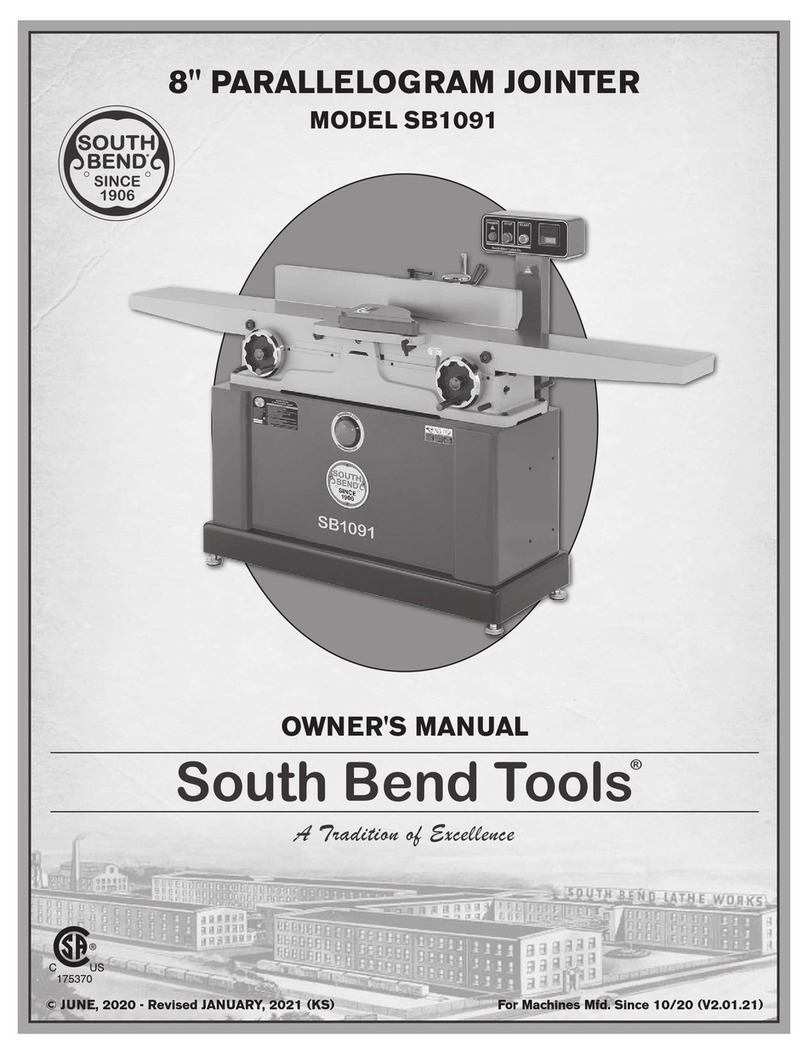
Southbend
Southbend SB1091 owner's manual

Woodie's
Woodie's Pro-Cut Plus PCP33MT instruction manual

Welbilt
Welbilt 151603 operating instructions

Parkside
Parkside PEH 30 A1 ELECTRIC PLANER Operation and safety notes
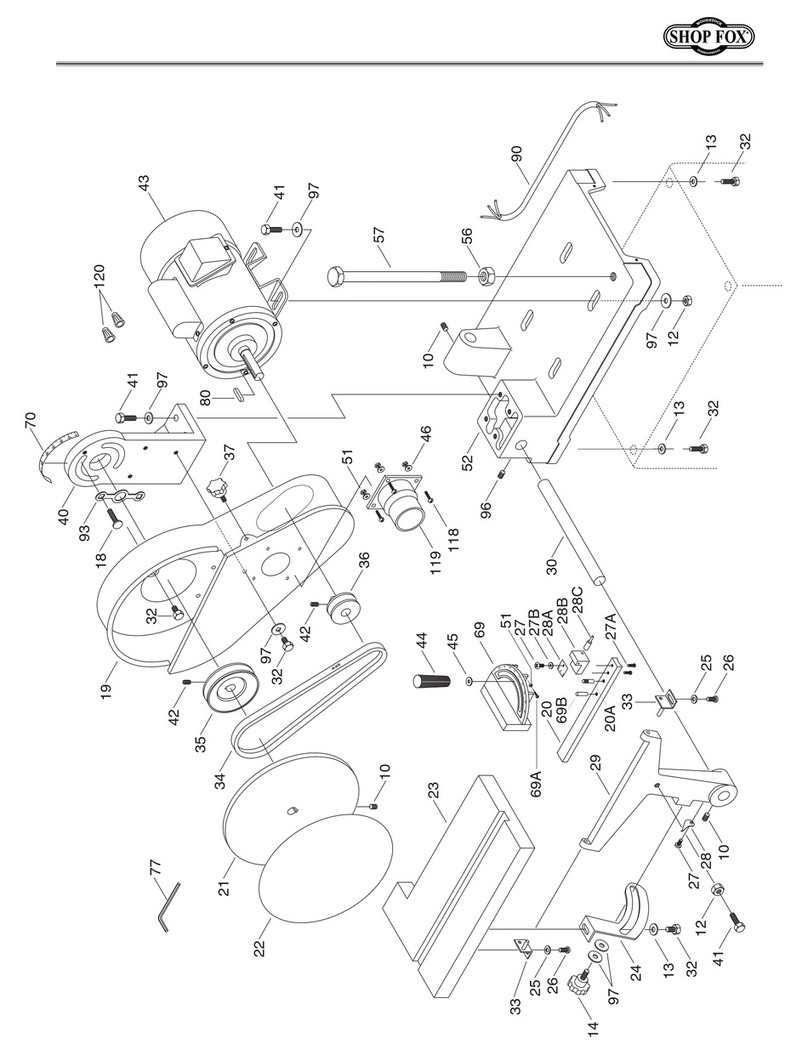
Woodstock
Woodstock G4790 parts list

Novakon Systems
Novakon Systems NM-200 Pro Series Operator's manual
